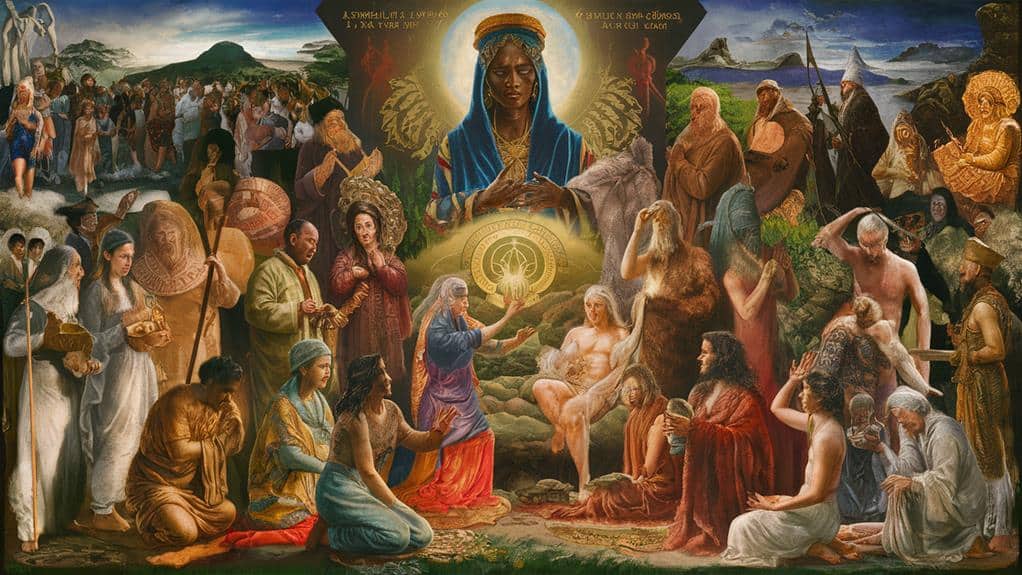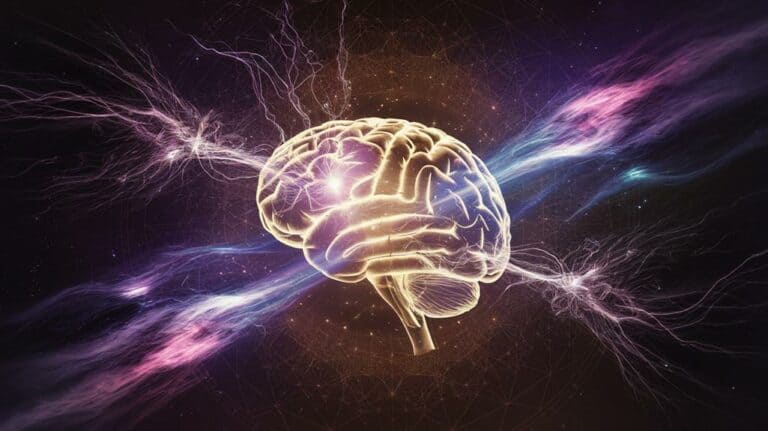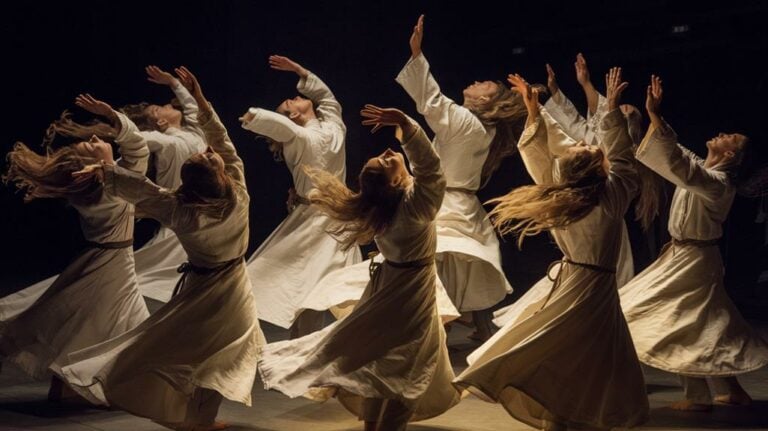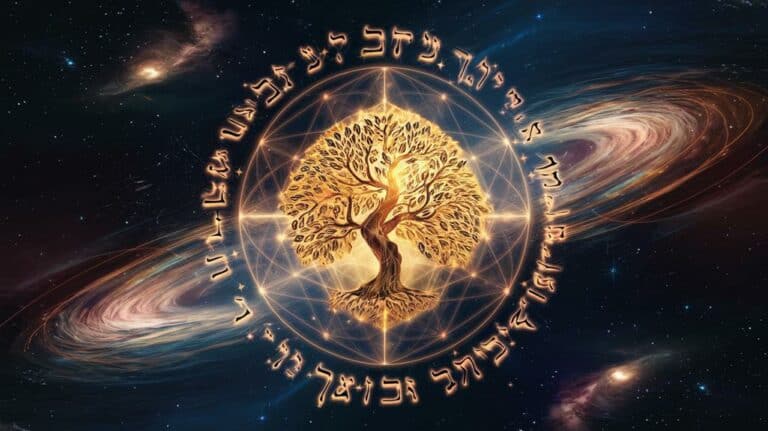An Introduction to the Study of Mysticism
When you initiate “An Introduction to the Study of Mysticism” by Richard H. Jones, you are plunged into a nuanced exploration of mystical experiences that transcend cultural and religious boundaries. This book lays out the foundations of mystical studies, distinguishing between extrovertive and introvertive mysticism and delving into the philosophical debates around duality and non-duality. You’ll discover how religious beliefs shape mystical practices and how psychological and neuroscientific perspectives illuminate the cognitive and neural mechanisms behind these profound experiences. As you begin this journey, you’ll find yourself pondering the universal quest for unity and transcendence that underpins human mysticism, and you’ll likely wonder: What lies at the heart of these altered states of consciousness, and how do they redefine our understanding of human consciousness itself?
Foundations of Mystical Studies

When delving into the foundations of mystical studies, it’s essential to understand the historical and philosophical roots that shape the discipline. Mysticism, derived from the Greek noun *mystes*, originally referred to initiates of secret cults or mystery religions in Classical Greece and the Hellenistic Age. These early practices involved rituals and ecstasies that were largely secret, setting the stage for later religious and philosophical interpretations.
As you explore these foundations, you’ll encounter various traditions that have shaped mystical thought. In Christianity, for example, mysticism evolved from early secrecy to a focus on religious ecstasy and contemplation of God’s essence. Terms like *unio mystica* (mystical union) emerged, emphasizing the soul’s rapture in contemplating the divine.
Mystical experiences, whether introvertive or extrovertive, are characterized by altered states of consciousness. These experiences aim to connect the individual with an ultimate reality beyond the physical world, often leading to profound personal transformations and a sense of unity or nothingness, depending on the tradition.
Understanding these historical and philosophical underpinnings allows you to appreciate the complexity and diversity of mystical experiences across cultures, inviting a deeper reflection on the human quest for ultimate meaning and connection with the divine.
Duality vs. Non-Duality
In exploring the concept of duality vs. non-duality in mystical studies, you’ll encounter two fundamental approaches that shape the nature of mystical experiences. Duality, a pervasive aspect of human existence, presents the world in clear polarities: good and evil, light and dark, self and other. This dualistic perspective is rooted in our everyday experiences, where distinctions and separations seem inherent and necessary.
However, non-dualistic teachings, found in traditions like Advaita Vedanta and certain schools of Buddhism, suggest that these distinctions are illusory, masking a deeper, unitive reality where all things are fundamentally interconnected and whole.
As you investigate non-duality, you may find that opposites aren’t contradictory but complementary, each defining the other. For instance, the concept of good only exists in relation to evil, and vice versa, much like the poles of a battery. Non-dual awareness, often achieved through practices like meditation and self-inquiry, reveals a reality where such polarities dissolve, uncovering a unified, seamless existence.
This perspective invites you to transcend the boundaries of dualistic thinking, embracing the dynamic interdependence of all phenomena and the underlying unity that underpins the diversity of life.
In this contemplative journey, you’re asked to integrate these divergent perspectives, recognizing the divine in the mundane and the sacred in the profane. The key to reconciling duality and non-duality lies in the embodied dance of your everyday life, where you learn to hold paradox and abide in the creative tension between opposites, cultivating greater wholeness and compassion within yourself.
Types of Mystical Experiences

As you explore the vast landscape of mystical experiences, you’ll encounter a diverse array of phenomena that reflect the depth and complexity of human spiritual inquiry.
One of the foundational distinctions in this domain is between extrovertive and introvertive mysticism, as outlined by W.T. Stace. Extrovertive mysticism involves an experience of unity within the world, where you feel a deep connection with all objects of perception, and this unity shines through the same world you continuously perceive. This type often encompasses nature mysticism, where you experience a oneness with the natural world, and cosmic consciousness, where you sense God or the Absolute immanent in nature.
In contrast, introvertive mysticism is characterized by an experience of unity devoid of perceptual objects, often described as an experience of ‘no-thing-ness’ or pure consciousness. Here, you connect with a unitary consciousness, feeling a sense of blessedness, peace, and the holy or divine, all without the presence of physical objects.
Additionally, scholars like R.C. Zaehner categorize mysticism into theistic, monistic, and panenhenic (or natural) types. Theistic mysticism, common in Jewish, Christian, and Islamic traditions, involves a personal relationship with God.
Monistic mysticism, seen in early Buddhism and Hindu schools like Advaita Vedanta, emphasizes the unity of the soul with a universal reality. Panenhenic or natural mysticism, found in Zen Buddhism and Taoism, focuses on experiencing unity within nature.
These categories underscore the rich and varied nature of mystical experiences, inviting you to explore and reflect on these profound states of consciousness.
Extrovertive and Introvertive Experiences
Extrovertive and introvertive mysticism, as distinguished by W.T. Stace, represent two distinct paths to experiencing the profound and the divine.
In extrovertive mystical experiences, you find unity through your senses, perceiving the world around you in a transcendent light. This type of experience involves a deep sense of connection with the external world, where the multiplicity of objects and sensations is transformed into a unified whole.
Imagine standing before a sunset, and instead of seeing just the sun, sky, and trees, you experience the oneness that underlies all these elements. This is an experience that transcends ordinary perception, revealing the divine or ultimate reality within the everyday world.
In contrast, introvertive mystical experiences are inwardly focused, devoid of sensory content. Here, you plunge into the depths of your own being, shutting off the external world to glimpse the ultimate reality.
This experience is often described as a void, a pure consciousness, or a unity with the ground of being. It’s a state where time, space, and the sense of self dissolve, leaving only an unmediated awareness of the One.
Both types of experiences share a common thread – the unitive quality that erases the distinctions between the self and the ultimate reality, inviting you to step into a domain beyond the ordinary.
The Role of Consciousness

Consciousness plays a pivotal role in mystical experiences, serving as the medium through which the mystic encounters the ultimate reality. In this domain, the boundaries of ordinary consciousness are transcended, allowing for a deeper, often unmediated connection with the divine or the absolute.
This altered state of consciousness isn’t merely a transient experience but a transformative one, aiming to embed lasting changes in the mystic’s perception and understanding of the world.
As you explore mystical practices, you may find that the goal isn’t the altered state itself, but the knowledge and insights it yields. This knowledge is believed to be inaccessible through normal states of consciousness, highlighting the essential role of consciousness in bridging the gap between the mundane and the transcendent.
The nature of this consciousness can vary; it may be extrovertive, where the unity of nature is experienced through sensory perception, or introvertive, where the focus is on an inner, often void-like awareness.
In either case, the mystic’s journey is one of self-transformation, seeking to align their consciousness with the fundamental essence of reality. This alignment is often described as a union that dissolves the dualistic distinctions between the self and the ultimate reality, leading to a profound sense of unity and understanding.
Impact of Religious Beliefs
The impact of religious beliefs on mystical experiences is profound, as these beliefs often shape the nature and interpretation of the mystic’s encounter with the ultimate reality. When you set out on a mystical journey, your existing religious framework can influence what you perceive and how you understand your experiences.
For instance, a Christian mystic may interpret their union with the divine through the lens of Christ’s teachings, seeing it as a manifestation of the Holy Spirit filling their mind and spirit, aligning their will with God’s.
Your religious beliefs can also color the metaphors and analogies you use to describe your mystical experiences. Christian mystics, for example, might liken union with God to a drop of water merging with wine or a sponge absorbing water, reflecting their theological understanding of becoming one with Christ.
Moreover, the specific practices and traditions within your religion can guide your mystical path. Apophatic mysticism, which emphasizes the indescribable nature of God, is an approach that resonates deeply with some Christian mystics, while others may find kataphatic mysticism, which affirms positive attributes of God, more aligning with their faith.
As you investigate mysticism, it’s essential to recognize that your religious beliefs aren’t obstacles but rather tools that can deepen your connection with the divine, inviting you to explore and understand the mysteries of existence in a profoundly personal way.
Mysticism in Human Culture

Mystical experiences have been a pervasive and influential aspect of human culture, transcending geographical and temporal boundaries. From the ancient Greek philosophers who contemplated the extrasensory dimensions of reality, to the medieval Christian mystics who sought a spiritual marriage with God, these experiences have shaped the spiritual and philosophical landscapes of various cultures.
In many traditions, mysticism isn’t just a personal experience but a communal and cultural practice. For example, in Daoism, the human microcosm is seen as mirroring the cosmos, making visions a reliable means to understand the Dao.
In Hinduism and Buddhism, mystical practices such as yoga and meditation are designed to transcend the illusion of the material world and achieve a state of pure consciousness or nothingness.
These experiences often blur the lines between the personal and the universal, inviting individuals to see themselves as part of a larger, interconnected whole. Whether through the contemplation of intelligibles in the Platonic tradition or the ecstatic union with the Absolute in Christian mysticism, these practices reflect a deep human yearning to connect with something beyond the mundane.
As you explore into the world of mysticism, you’re encouraged to investigate these diverse practices and philosophies, allowing yourself to be transformed by the profound insights and experiences that they offer.
This journey can lead you to a deeper understanding of yourself and the world, fostering a sense of unity and transcendence that resonates across cultures and centuries.
Psychological and Neuroscientific Perspectives
As you investigate the psychological and neuroscientific perspectives on mysticism, you’ll find that researchers have been actively exploring the cognitive and neural mechanisms underlying mystical experiences.
Neurophenomenology, for instance, integrates third-person neurophysiological data with first-person phenomenological accounts, allowing for a deeper understanding of how these experiences are both culturally constructed and universally rooted in innate neurological functions.
Studies in neurotheology, a field that combines neuroscience and theology, have used brain imaging techniques like SPECT, PET, and fMRI to analyze the brains of individuals during religious practices such as prayer and meditation.
These studies reveal that such practices engage multiple areas of the brain, including emotional, memory, and experiential centers, leading to long-term changes in brain structure and function.
These findings suggest that mystical experiences, while interpreted through cultural and religious frameworks, are grounded in universal neurognostic processes.
The homologous features of these experiences across diverse traditions point to a common underlying neurology, indicating that the human brain may be “wired” for specific aspects of mystical experiences.
This intersection of neuroscience and mysticism invites you to ponder the intricate relationship between the brain, consciousness, and the transcendent, offering a profound glimpse into the human quest for meaning and connection.









